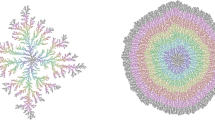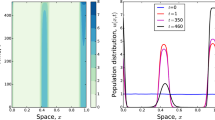Abstract
We construct a continuum model for biological aggregations in which individuals experience long-range social attraction and short-range dispersal. For the case of one spatial dimension, we study the steady states analytically and numerically. There exist strongly nonlinear states with compact support and steep edges that correspond to localized biological aggregations, or clumps. These steady-state clumps are reached through a dynamic coarsening process. In the limit of large population size, the clumps approach a constant density swarm with abrupt edges. We use energy arguments to understand the nonlinear selection of clump solutions, and to predict the internal density in the large population limit. The energy result holds in higher dimensions as well, and is demonstrated via numerical simulations in two dimensions.
Similar content being viewed by others
References
Aldana, M., Huepe, C., 2003. Phase transitions in self-driven many-particle systems and related non-equilibrium models: A network approach. J. Stat. Phys. 112(1–2), 135–153.
Alt, W., 1985. Degenerate diffusion equations with drift functionals modeling aggregation. Nonlinear Anal. 9, 811–836.
Bates, P., Fife, P., 1990. Spectral comparison principles for the Cahn–Hilliard and phase-field equations, and time scales for coarsening. Physica D 43(2–3), 335–348.
Ben-Jacob, E., Cohen, I., Levine, H., 2000. Cooperative self-organization of microorganisms. Adv. Phys. 49(4), 395–554.
Bertozzi, A., Grün, G., Witelski, T., 2001. Dewetting films: Bifurcations and concentrations. Nonlinearity 14(6), 1569–1592.
Breder, C., 1954. Equations descriptive of fish schools and other animal aggregations. Ecology 35(3), 361–370.
Bressloff, P., 2004. Euclidean shift-twist symmetry in population models of self-aligning objects. SIAM J. Appl. Math. 64(5), 1668–1690.
Cahn, J., 1968. Spinodal decomposition. Trans. Metall. Soc. AIME 242, 166–180.
Camazine, S., Deneubourg, J., Franks, N., Sneyd, J., Theraulaz, G., Bonabeau, E., 2001. Self-Organization in Biological Systems. Princeton Studies in Complexity. Princeton University Press, Princeton, NJ.
Couzin, I., Krause, J., James, R., Ruxton, G., Franks, N., 2002. Collective memory and spatial sorting in animal groups. J. Theor. Biol. 218(1), 1–11.
Crawford, J., 1991. Introduction to bifurcation theory. Rev. Mod. Phys. 63(4), 991–1037.
Cross, M., Hohenberg, P., 1993. Pattern formation outside of equilibrium. Rev. Mod. Phys. 65(3), 851–1112.
dal Passo, R., Demottoni, P., 1984. Aggregative effects for a reaction–advection equation. J. Math. Biol. 20, 103–112.
Edelstein-Keshet, L., Watmough, J., Grünbaum, D., 1998. Do travelling band solutions describe cohesive swarms? An investigation for migratory locusts. J. Math. Biol. 36(6), 515–549.
Eilbeck, J., Furter, J., Grinfeld, M., 1989. On a stationary state characterization of transition from spinodal decomposition to nucleation behaviour in the Cahn–Hilliard model of phase separation. Phys. Lett. A 135(4–5), 272–275.
Erdmann, U., Ebeling, W., 2003. Collective motion of Brownian particles with hydrodynamic interactions. Fluct. Noise Lett. 3(2), L145–L154.
Erdmann, U., Ebeling, W., Anishchenko, V., 2002. Excitation of rotational modes in two-dimensional systems of driven Brownian particles. Phys. Rev. E 65, 061106.1–061106.9.
Flierl, G., Grünbaum, D., Levin, S., Olson, D., 1999. From individuals to aggregations: The interplay between behavior and physics. J. Theor. Biol. 196(4), 397–454.
Glasner, K., Witelski, T., 2003. Coarsening dynamics of dewetting films. Phys. Rev. E 67, 016302.1–016302.12.
Grégoire, G., Chaté, H., 2004. Onset of collective and cohesive motion. Phys. Rev. Lett. 92(2), 025702.1–025702.4.
Grégoire, G., Chaté, H., Tu, Y., 2001. Active and passive particles: Modeling beads in a bacterial bath. Phys. Rev. E 64(1), 011902.1–011902.7.
Grégoire, G., Chaté, H., Tu, Y., 2003. Moving and staying together without a leader. Physica D 181(3–4), 157–170.
Grünbaum, D., Okubo, A., 1994. Modelling social animal aggregations. In: Levin, S. (Ed.), Frontiers in Mathematical Biology. Lecture Notes in Biomathematics, vol. 100. Springer-Verlag, Berlin, pp. 296–325.
Holm, D., Putkaradze, V., 2005. Aggregation of finite size particles with variable mobility, Phys. Rev. Lett. 95(22), 226106.1–226106.4.
Hosono, Y., Mimura, M., 1989. Localized cluster solutions of nonlinear degenerate diffusion equations arising in population dynamics. SIAM J. Math. Anal. 20, 845–869.
Ikeda, T., 1984. Stationary solutions of a spatially aggregating population model. Proc. Jpn. Acad. A 60, 46–48.
Ikeda, T., 1985. Standing pulse-like solutions of a spatially aggregating population model. Jpn. J. Appl. Math. 2, 111–149.
Ikeda, T., Nagai, T., 1987. Stability of localized stationary solutions. Jpn. J. Appl. Math. 4, 73–97.
Kawasaki, K., 1978. Diffusion and the formation of spatial distributions. Math. Sci. 16(183), 47–52.
Levine, H., Rappel, W., Cohen, I., 2001. Self-organization in systems of self-propelled particles. Phys. Rev. E 63, 017101.1–017101.4.
Mimura, M., Yamaguti, M., 1982. Pattern formation in interacting and diffusing systems in population biology. Adv. Biophys. 15, 19–65.
Mogilner, A., Edelstein-Keshet, L., 1999. A non-local model for a swarm. J. Math. Biol. 38(6), 534–570.
Mogilner, A., Edelstein-Keshet, L., Bent, L., Spiros, A., 2003. Mutual interactions, potentials, and individual distance in a social aggregation. J. Math. Biol. 47(4), 353–389.
Nagai, T., Mimura, M., 1983. Asymptotic behavior for a nonlinear degenerate diffusion equation in population dynamics. SIAM J. Appl. Math. 43, 449–464.
Okubo, A., 1980. Diffusion and Ecological Problems. Springer, New York.
Okubo, A., Grünbaum, D., Edelstein-Keshet, L., 2001. The dynamics of animal grouping. In: Okubo, A., Levin, S. (Eds.), Diffusion and Ecological Problems, 2nd edition. Interdisciplinary Applied Mathematics: Mathematical Biology, vol. 14. Springer Verlag, New York, Chapter 7, pp. 197–237.
Okubo, A., Levin, S. (Eds.), 2001. Diffusion and Ecological Problems, 2nd edition. Interdisciplinary Applied Mathematics: Mathematical Biology, vol. 14. Springer, New York.
Okubo, A., Sakamoto, W., Inagaki, T., Kuroki, T., 1977. Studies on the schooling behavior of fish. Bull. Jpn. Soc. Sci. Fish 9, 1369–1377.
Oron, A., Bankoff, S., 2001. Dynamics of a condensing liquid film under conjoining/disjoining pressures. Phys. Fluids 13(5), 1107–1117.
Parrish, J., Edelstein-Keshet, L., 1999. Complexity, pattern, and evolutionary trade-offs in animal aggregation. Science 284, 99–101.
Parrish, J., Hamner, W. (Eds.), 1997. Animal Groups in Three Dimensions. Cambridge University Press, Cambridge, UK.
Parrish, J., Viscido, S., Grünbaum, D., 2003. Self-organized fish schools: An examination of emergent properties. Bio. Bull. 202(3), 296–305.
Sakai, S., 1973. A model for group structure and its behavior. Biophysics 13, 82–90.
Satsuma, J., Mimura, M., 1985. Exact treatments of nonlinear diffusion equations with singular integral terms. J Phys. Soc. Jpn. 54, 894–900.
Schweitzer, F., Ebeling, W., Tilch, B., 2001. Statistical mechanics of canonical-dissipative systems and applications to swarm dynamics. Phys. Rev. E 64, 021110.1–0211101.2.
Simha, R., Ramaswamy, S., 2002a. Hydrodynamic fluctuations and instabilities in ordered suspensions of self-propelled particles. Phys. Rev. Lett. 89(5), 028181.1–058101.4.
Simha, R., Ramaswamy, S., 2002b. Statistical hydrodynamics of ordered suspensions of self-propelled particles: Waves, giant number fluctuations and instabilities. Physica A 306, 262–269.
Suzuki, R., Sakai, S., 1973. Movement of a group of animals. Biophysics 13, 281–282.
Toner, J., Tu, Y., 1998. Flocks, herds, and schools: A quantitative theory of flocking. Phys. Rev. E 58(4), 4828–4858.
Topaz, C., Bertozzi, A., 2004. Swarming patterns in a two-dimensional kinematic model for biological groups. SIAM J. Appl. Math. 65(1), 152–174.
Tyutyunov, Y., Senina, I., Arditi, R., 2004. Clustering due to acceleration in the response to population gradient: A simple self-organizational model. Am. Nat. 164(6), 722–735.
Vicsek, T., Czirók, A., Ben-Jacob, E., Cohen, I., Shochet, O., 1995. Novel type of phase transition in a system of self-driven particles. Phys. Rev. Lett. 75(6), 1226–1229.
Author information
Authors and Affiliations
Corresponding author
Rights and permissions
About this article
Cite this article
Topaz, C.M., Bertozzi, A.L. & Lewis, M.A. A Nonlocal Continuum Model for Biological Aggregation. Bull. Math. Biol. 68, 1601–1623 (2006). https://doi.org/10.1007/s11538-006-9088-6
Received:
Accepted:
Published:
Issue Date:
DOI: https://doi.org/10.1007/s11538-006-9088-6




